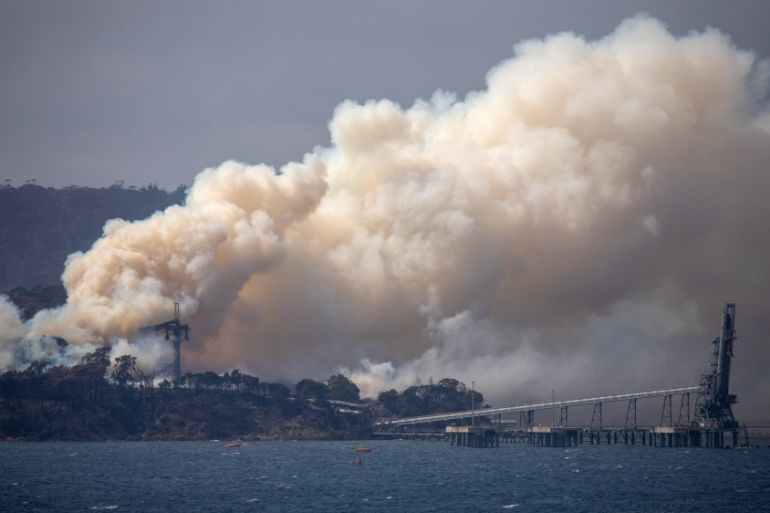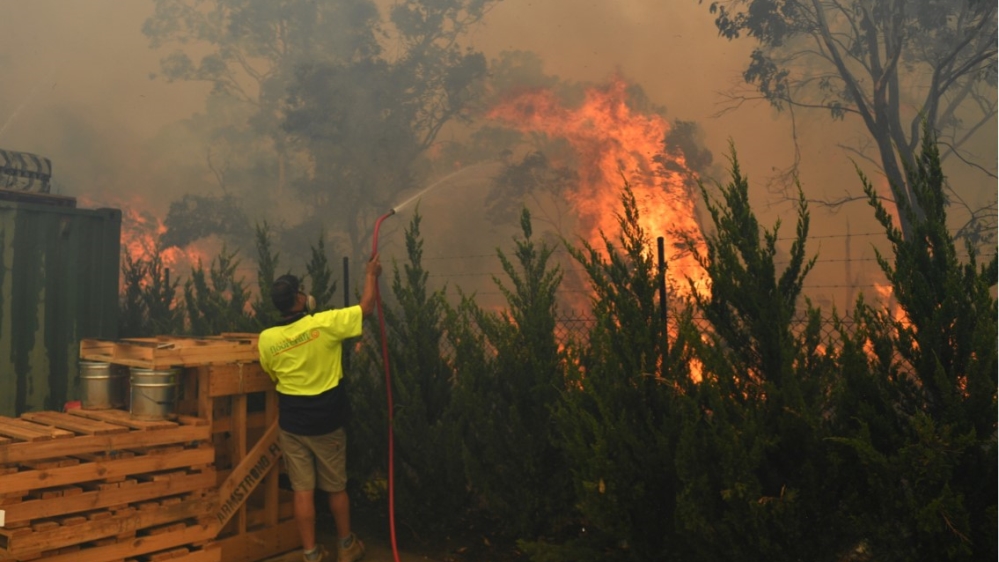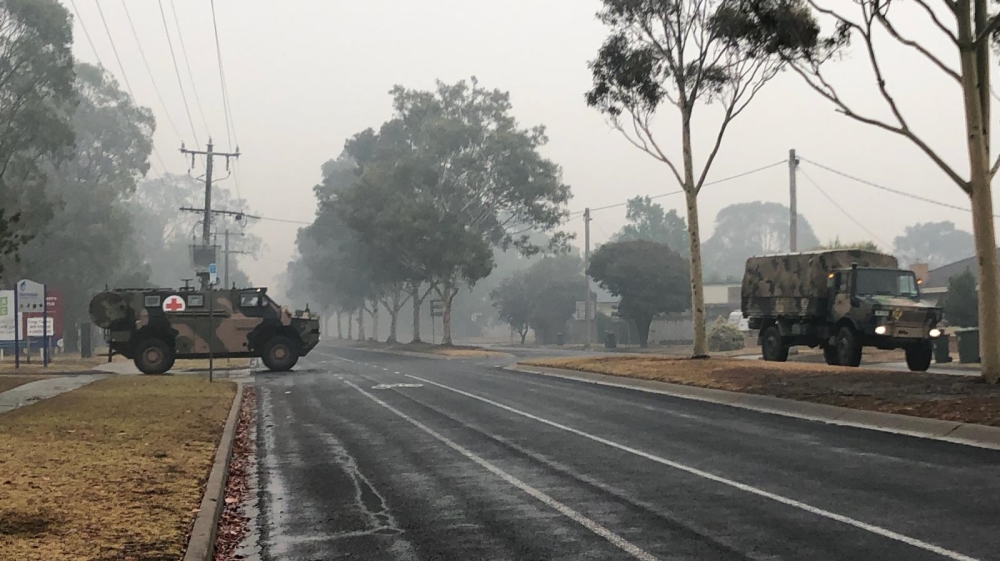‘We are a ghost town’: Counting the cost of Australia’s bushfires
The agriculture and tourism industries are feeling the worst effects of Australia’s devastating bushfire season.

Eden, Australia – For much of the new year, Eden, on Australia’s southeastern coast, has been anything but paradise. Despite recent rains in some parts of fire-ravaged Australia, a smoke haze has hung over this town in the state of New South Wales.
Many residents in the area have been in limbo for weeks, after a horrific bushfire season displaced communities and engulfed more than 10 million hectares (24.7 million acres) across southeastern Australia, an area greater than the size of South Korea.
Keep reading
list of 4 itemsCould shipping containers be the answer to Ghana’s housing crisis?
Thousands protest against over-tourism in Spain’s Canary Islands
Holding Up the Sky: Saving the Indigenous Yanomami tribe in Brazil’s Amazon
Eden was surrounded by fires after December 25 and into the new year and, while the immediate threat has lessened, the effect of the fires on industry here and across Australia is starting to become apparent.
“We are a ghost town,” Eden restaurateur Diana Stojanovic told Al Jazeera, adding that the fire cut off the main highway between Melbourne and Sydney, which passes near Eden.
“After 20 years running my cafe at the wharf area, this is extremely upsetting. We have all been waiting for something to boost Eden’s economy. Now with the fires, we are laying off staff. The town is suffering, our country is suffering,” said Stojanovic.
Bushfires are an accepted part of life in rural Australia but the blazes this summer have been exceptional, contributing to the worst fire season in the recorded history of New South Wales, Australia’s most populous state.
While some towns continue to defend themselves against the fire front, the national focus has turned to how the disaster will affect economies – both local and federal – now and into the future.
So far, the impact of the fires on the broader Australian economy seems to be minimal. But some sections of society are paying a disproportionately higher price.
“The costs also remain manageable for the general government, with the immediate fiscal costs expected to be less than 0.1 percent of Australia’s gross domestic product in 2020 and 2021,” Moody’s Analytics said in a recent statement.
And AMP Capital’s head economist Shane Oliver predicts the fires will shave about 0.4 percentage points off Australia’s economic growth rate this year.
“Physical disasters invariably cause a brief disruption to economic activity as measured by GDP followed by a boost as wealth destroyed by the disaster is rebuilt. In this sense measured across a year or so they are often seen as positive for economic growth, albeit this seems perverse particularly for those directly impacted,” Oliver said in a research note.
Tourism and agriculture impacted
The results of a survey published on January 22 suggest a tough period ahead for many Australian industries. Consumer sentiment fell by 6.2 percent in January compared with the same month last year, according to the Westpac-Melbourne Institute Index.

But the damage is not evenly spread, with people in rural communities experiencing the worst of the economic impact. Pockets of Australia’s tourism and agriculture industries have been dealt a particularly heavy blow.
“In evacuated areas, residents are asked to make the choice to leave immediately or prepare to defend their homes or businesses against the fire. During this time, economic activity virtually shuts down,” Marcia Keegan, an associate and partner at research firm SGS Economics, told Al Jazeera.
“This is especially difficult for the areas that are beach holiday towns … which are shutting down during their peak tourist period.”
Tourism accounts for 3.1 percent of Australia’s economy and employs 666,000 people, or 5.2 percent of the country’s workforce, according to government figures. More than nine million people visited Australia last year from overseas, and spent more than $30bn, both figures higher than the previous year. Domestic tourism has also been on the rise.
The government has promised help for the sector.
“One in thirteen Australian jobs rely on tourism and hospitality so our $76 million investment is an urgent injection to help all those hotels, restaurants and cafes and tour operators get back on their feet,” Prime Minister Scott Morrison said in a statement.
“This is make or break for many businesses and tourist hot spots and not just in those areas directly hit by the bushfires.”
Agriculture is also badly affected, although losses in this industry may be less visible than in other sectors of the economy.
The latest government figures say more than 46,000 head of livestock have been lost in the fires.
Meat and Livestock Australia, an industry body, says 30 percent of the national sheep flock and 20 percent of the national cattle herd have been either directly or partially impacted by the fires.
“It has been a devastating start to 2020 for many red meat and livestock producers,” its managing director, Jason Strong said in a statement.
Cherries, bees and abalone
Meanwhile, smaller – in some cases unique – industries have also felt the brunt of the disaster, such as cherry farming, forestry and abalone production. Some of these sectors may take years to recover, if they ever do.

Among these is the beekeeping industry. More than 4,600 beehives have been destroyed with a further 23,000 suffering significant losses.
Adding to the strain on the economy is the impact of bushfire smoke on surrounding metropolitan areas. When the smoke haze has been at its worst – both Melbourne and Canberra’s air quality was rated the worst in the world at the height of the fires – some businesses have been forced to cease operations.
The federal government has committed 2 billion Australian dollars ($1.4bn) to fund a new National Bushfire Recovery Agency (NBRA), dipping into the budget surplus delivered by federal treasurer Josh Frydenberg in 2019. It aims to help farmers and small businesses, and to attract tourists back to regions affected by the fires.
But with scientists forecasting hotter, longer summers across Australia, analysts say these numbers are going to have to increase.
Deloitte Access Economics said in a 2017 report that the total economic cost of natural disasters in Australia is growing and will reach 39 billion Australian dollars ($26.6bn) a year by 2050.
David Pannell, director of the Centre for Environmental Economics and Policy at the University of Western Australia, says the Australian economy – and its agriculture sector in particular – are not ready for the effects of such catastrophic fires.
“If fires of this scale and intensity do become the new normal, I don’t believe agriculture is prepared for the repercussions,” he told Al Jazeera. “For that matter, neither is government or the community”.
“It would be such a big change from what we are used to that almost nobody is mentally or practically prepared for it”.